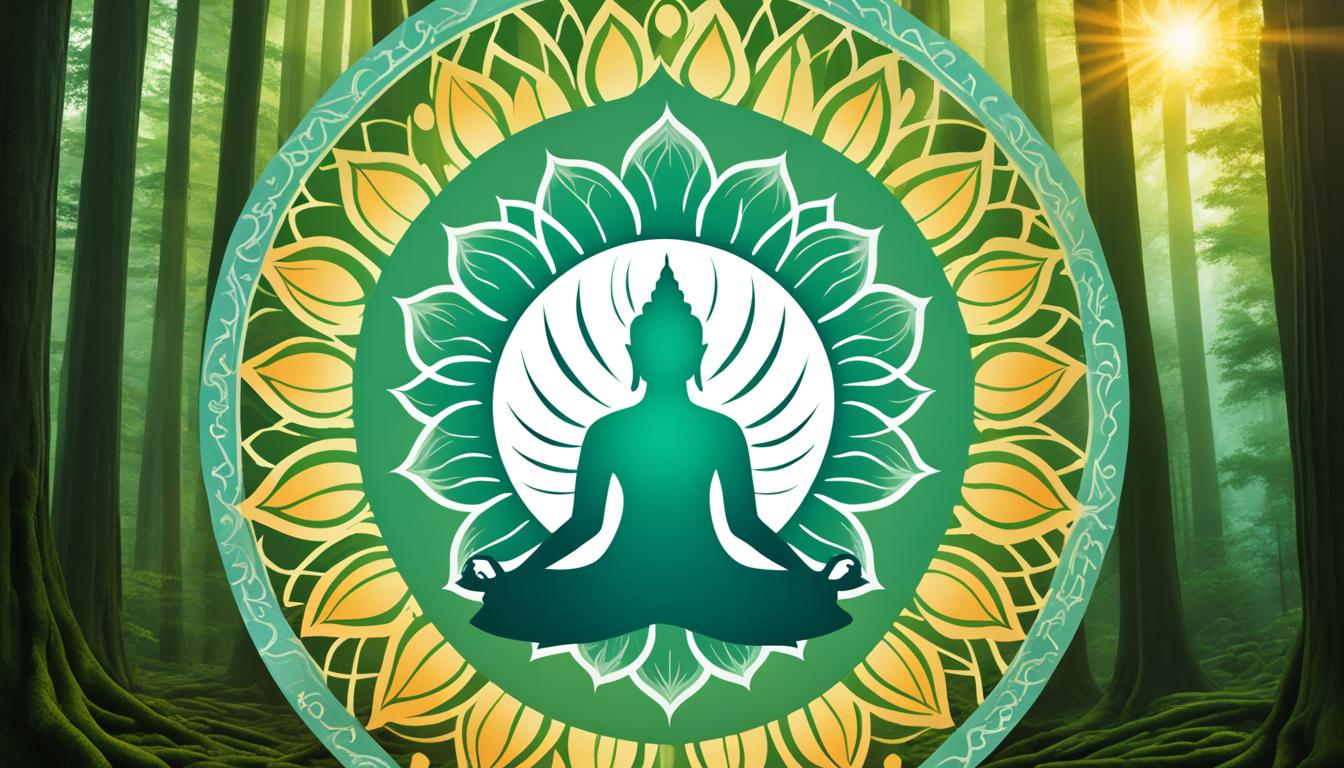Have you ever wondered what lies at the heart of Buddhism, one of the world’s oldest and most influential religions? What are the fundamental beliefs that guide its followers in their quest for peace and enlightenment? Join us on a journey as we delve deep into the core tenets of Buddhism and uncover the profound wisdom they offer for navigating the complexities of modern life.
Key Takeaways:
- Discover the Three Universal Truths and how they shape the Buddhist worldview.
- Explore the Four Noble Truths and the Middle Path as guiding principles for ending suffering.
- Uncover the importance of meditation and mindfulness in cultivating inner peace.
- Gain insights into the relevance of Buddhist teachings for personal and societal harmony in the modern world.
- Understand how Buddhism’s core beliefs can empower you to find meaning and purpose in your life.
The Three Universal Truths
In Buddhism, the Three Universal Truths form the core principles that provide insight into the nature of existence and guide practitioners towards liberation from suffering. These truths highlight the impermanence and constant change in life, the dissatisfaction and suffering caused by attachment, and the absence of an eternal, unchanging self.
Impermanence: Life is characterized by constant change and flux. Nothing remains the same, and all things are subject to birth, decay, and death. This truth encourages us to embrace the transitory nature of life, letting go of attachments and expectations. By recognizing impermanence, we can cultivate resilience and adaptability.
Suffering caused by attachment: Human suffering arises from our attachment to desires, illusions, and fleeting pleasures. The craving for permanence and the resistance to change lead to disappointment and dissatisfaction. By understanding the impermanence of all things and letting go of attachment, we can alleviate suffering and find contentment in the present moment.
Absence of an eternal, unchanging self: Buddhism rejects the notion of an eternal, unchanging self or soul. Instead, it teaches that our sense of self is a construct influenced by various factors, such as thoughts, emotions, and experiences. This understanding challenges the concept of a fixed identity and encourages us to let go of ego-driven desires and attachments.
By accepting the Three Universal Truths, we gain insights into the transient nature of life, the causes of suffering, and the path towards liberation. Through practice and mindfulness, we can cultivate inner peace, compassion, and wisdom.

Next, let’s explore the Four Noble Truths and the Middle Path, which provide further guidance on ending suffering and finding inner harmony.
The Four Noble Truths and the Middle Path
The Four Noble Truths are at the core of Buddhist teachings. They provide a profound understanding of the nature of suffering and the path to liberation. These truths guide individuals towards finding inner peace and living harmoniously with the world around them.
The First Noble Truth acknowledges that life is filled with suffering. It recognizes the inevitable presence of pain, loss, and dissatisfaction in our lives. By accepting this truth, we can begin to explore the causes of our suffering and seek ways to overcome it.
The Second Noble Truth reveals that suffering is caused by our desires and attachments. Our cravings and attachments to material possessions, relationships, and even ideas lead to a sense of discontentment and perpetual dissatisfaction. By recognizing and letting go of these attachments, we can find freedom from suffering.
The Third Noble Truth offers hope by stating that there is a way to end suffering. It presents the possibility of liberation and finding true happiness by eliminating attachments and desires that cause suffering. This truth gives us the motivation to pursue a path of transformation.
The Fourth Noble Truth is the Middle Path, also known as the Eightfold Path. It provides a practical and ethical framework for living a meaningful and fulfilling life. The Eightfold Path consists of eight principles that guide us towards liberation from suffering:
- Right Understanding
- Right Values and Attitude
- Right Speech
- Right Action
- Right Work
- Right Effort
- Right Mindfulness
- Right Meditation
Following the Middle Path allows individuals to find balance and harmony in their lives. It encourages us to cultivate wisdom, ethical conduct, and mental clarity. Through practicing these principles, we can gradually transform ourselves and attain enlightenment.
The Eightfold Path
| Principle | Description |
|---|---|
| Right Understanding | Gaining insight into the true nature of reality and the Four Noble Truths. |
| Right Values and Attitude | Cultivating wholesome intentions, compassion, and kindness towards all beings. |
| Right Speech | Speaking truthfully, kindly, and avoiding harmful or divisive speech. |
| Right Action | Engaging in actions that promote well-being and avoiding actions that cause harm. |
| Right Work | Pursuing a livelihood that is ethical and promotes the welfare of others. |
| Right Effort | Making a persistent effort to cultivate positive qualities and overcome negative tendencies. |
| Right Mindfulness | Developing a clear and non-judgmental awareness of our thoughts, feelings, and sensations in the present moment. |
| Right Meditation | Cultivating concentration and insight through various meditation practices. |

Meditation and the Importance of Mindfulness
Meditation is an integral part of Buddhism, offering practitioners a path to achieve inner stillness and enlightenment. It is a practice that can take various forms, allowing individuals to find a method that resonates with them. Some practitioners prefer sitting quietly in meditation, while others may engage in activities such as practicing martial arts, contemplating riddles or poems, or using mandalas. Regardless of the form it takes, meditation serves as a powerful tool for cultivating mindfulness.
Mindfulness is a key aspect of Buddhist practice, encouraging individuals to be fully present and aware of their thoughts, feelings, and actions in the present moment. By cultivating mindfulness, Buddhists aim to gain insight into the nature of reality and attain liberation from suffering. It is through this practice of being fully present and attentive that individuals can develop a deep understanding of themselves and the world around them.

By incorporating meditation and mindfulness into their daily lives, Buddhists strive to transcend the limitations of the ego and connect with a deeper sense of self and the world. Through the practice of meditation, individuals learn to observe their thoughts and emotions without judgment, cultivating a sense of clarity and inner peace.
Mindfulness also extends beyond formal meditation practice, influencing everyday actions and interactions. It encourages individuals to approach each moment with awareness, gratitude, and compassion. By continuously returning to the present moment and letting go of attachment to past or future thoughts, Buddhists develop a heightened sense of presence and engagement.
The Benefits of Meditation and Mindfulness
The benefits of meditation and mindfulness extend to all aspects of life. These practices have been scientifically proven to reduce stress, anxiety, and depression, while improving overall mental well-being. They enhance concentration, focus, and creativity, enabling individuals to navigate challenges with clarity and resilience.
Additionally, meditation and mindfulness foster a greater sense of interconnectedness and empathy. By developing compassion towards oneself and others, Buddhists cultivate harmonious relationships and contribute positively to their communities.
Comparing Different Forms of Buddhist Meditation
| Form of Meditation | Description |
|---|---|
| Zazen | A form of seated meditation where one focuses on breath and posture. |
| Loving-kindness Meditation | Practicing compassion and sending well-wishes to oneself and others. |
| Vipassana Meditation | Insight meditation where practitioners observe sensations and thoughts. |
| Walking Meditation | Mindful walking, paying attention to each step and the sensations it brings. |
Each form of meditation offers unique benefits and resonates with different individuals. The key is to find a practice that aligns with one’s preferences and fosters a sense of connection and presence.
Conclusion
Buddhism’s core beliefs encompass profound insights into the nature of existence and the human condition. With a focus on understanding suffering, impermanence, and the absence of an eternal self, Buddhists navigate their journey towards enlightenment and liberation from suffering. At the heart of this path lie the Four Noble Truths and the Middle Path.
The Four Noble Truths address the existence of suffering, its cause in desires and attachments, the possibility of ending suffering, and the path to its cessation. This path, known as the Middle Path or the Eightfold Path, guides practitioners to cultivate right understanding, values, speech, action, work, effort, mindfulness, and meditation.
By embracing these teachings, individuals can nurture inner peace, compassion, and wisdom. Buddhism’s timeless principles offer profound guidance for personal and societal harmony in the modern world. The transformative power of these beliefs and practices continues to impact countless lives, offering solace, enlightenment, and the promise of transcending suffering.
FAQ
What are the core beliefs of Buddhism?
The core beliefs of Buddhism revolve around the understanding of suffering, impermanence, and non-self. Buddhists also seek enlightenment and liberation from suffering.
What are the Three Universal Truths of Buddhism?
The Three Universal Truths are impermanence and constant change, the dissatisfaction and suffering caused by attachment, and the absence of an eternal, unchanging self.
What are the Four Noble Truths and the Middle Path?
The Four Noble Truths state that life is suffering, suffering is caused by desires and attachments, there is a way to end suffering, and the path to end suffering is the Middle Path. The Middle Path, also known as the Eightfold Path, consists of eight principles that guide individuals towards liberation from suffering.
What is the importance of meditation and mindfulness in Buddhism?
Meditation is an integral part of Buddhism, with practitioners seeking inner stillness and enlightenment. Mindfulness, cultivated through meditation, involves being fully present and aware of one’s thoughts, feelings, and actions in the present moment. Through these practices, Buddhists aim to gain insight into the nature of reality and attain liberation from suffering.
How does Buddhism offer guidance for personal and societal harmony?
Buddhism offers guidance for personal and societal harmony through its teachings and practices. By understanding suffering, impermanence, and non-self, individuals can cultivate inner peace, compassion, and wisdom. The Four Noble Truths and the Middle Path provide a framework for ending suffering, while meditation and mindfulness help individuals develop self-awareness and insight. These principles and practices can contribute to a more harmonious and compassionate society.

